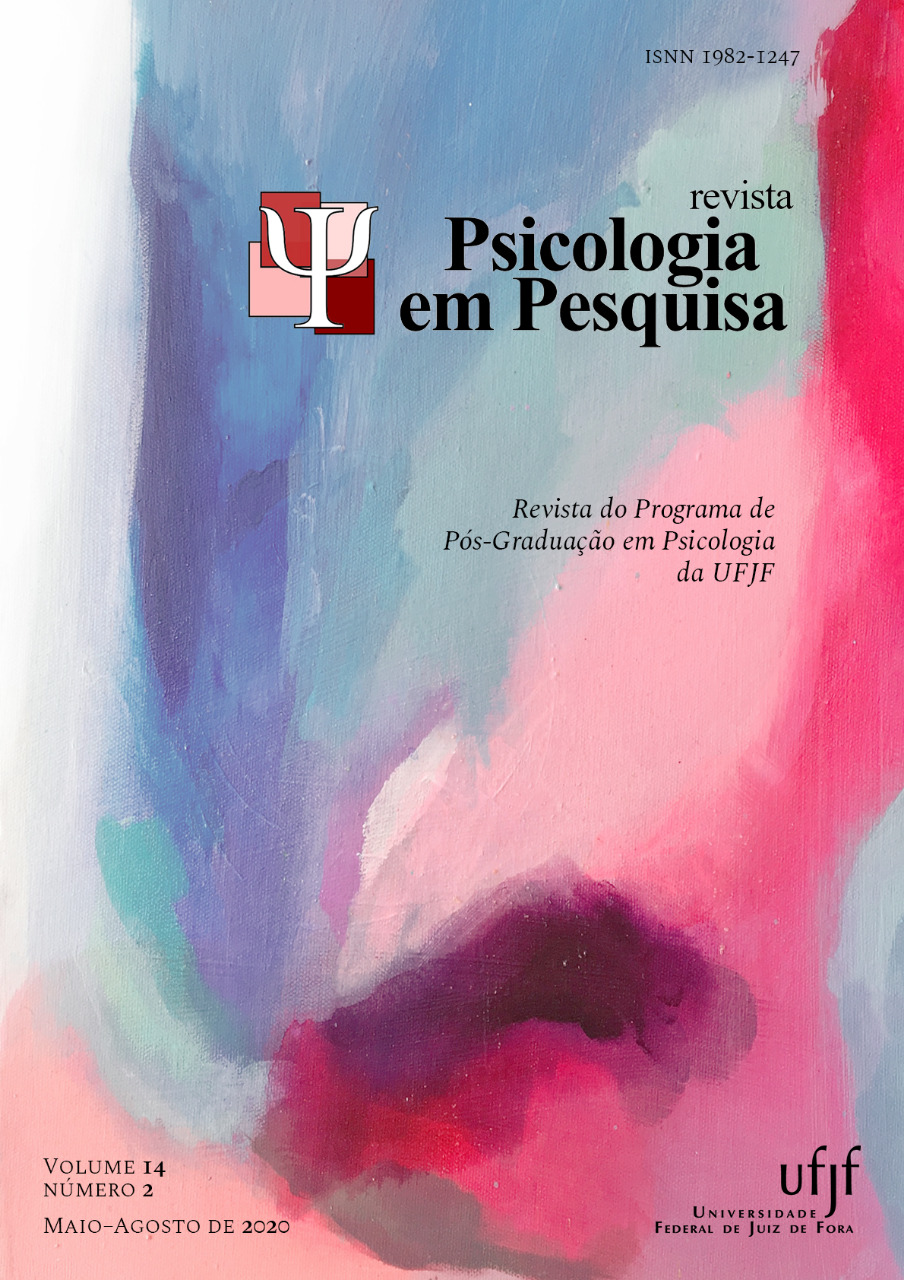Como delimitar e descrever um sistema de Memória Humana?
DOI:
https://doi.org/10.34019/1982-1247.2020.v14.27752Palavras-chave:
Psicologia cognitiva, Psicologia experimental, MemóriaResumo
O estudante ou pesquisador que inicia seus estudos em Psicologia Cognitiva geralmente aprende sobre o funcionamento de diversos sistemas de memória (e.g. memória declarativa/explícita e não-declarativa/implícita, memória episódica, memória semântica, memória operacional/de trabalho, memória procedural), mas não tem acesso aos detalhes do processo científico de descrição desses sistemas. De maneira semelhante, o profissional clínico pode enfrentar dificuldades para compreender os detalhes metodológicos dos estudos que originaram ferramentas de avaliação e intervenção neuropsicológica ao consultar a literatura científica da área. O objetivo deste artigo é apresentar uma visão global dos desafios teóricos e metodológicos no estudo da memória humana, com ênfase na delimitação dos sistemas de memória.
Downloads
Referências
Bunge, M. (1998). Philosophy of science: from explanation to justification (Vol. 1). New Brunswick, NJ: Transaction Publishers.
Atkinson, R. C., & Shiffrin, R. M. (1968). Human Memory: A Proposed System and its Control Processes. In K. W. Spence & J. T. Spence (Eds.), The psychology of learning and motivation: II (pp. 89–195). Oxford: Academic Press. https://doi.org/10.1016/S0079-7421(08)60422-3
Baddeley, A. D., & Hitch, G. (1974). Working Memory. In Psychology of Learning and Motivation - Advances in Research and Theory (Vol. 8, pp. 47–89). Academic Press. https://doi.org/10.1016/S0079-7421(08)60452-1
Barrouillet, P., & Camos, V. (2012). As time goes by: temporal constraints in working memory. Current Directions in Psychological Science, 21(6), 413–419. https://doi.org/10.1177/0963721412459513
Campoy, G., Castellà, J., Provencio, V., Hitch, G. J., & Baddeley, A. D. (2015). Automatic semantic encoding in verbal short-term memory: Evidence from the concreteness effect. Quarterly Journal of Experimental Psychology, 68(4), 759–778. https://doi.org/10.1080/17470218.2014.966248
Cochran, K. J., Greenspan, R. L., Bogart, D. F., & Loftus, E. F. (2016). Memory blindness: Altered memory reports lead to distortion in eyewitness memory. Memory & Cognition, 44(5), 717–726. https://doi.org/10.3758/s13421-016-0594-y
Cohen, N. J., Poldrack, R. A., & Eichenbaum, H. (1997). Memory for Items and Memory for Relations in the Procedural/Declarative Memory Framework. Memory, 5(1–2), 131–178. https://doi.org/10.1080/741941149
Cowan, N. (1993). Activation, attention, and short-term memory. Memory & Cognition, 21(2), 162–167. https://doi.org/10.3758/BF03202728
Denis, M., & Kosslyn, S. M. (1999). Scanning visual mental images: A window on the mind. Cahiers de Psychologie Cognitive/Current Psychology of Cognition, 18(4), 409–465.
Ebbinghaus, H. (1885). Memory: A Contribution to Experimental Psychology. Retrieved from http://nwkpsych.rutgers.edu/~jose/courses/578_mem_learn/2012/readings/Ebbinghaus_1885.pdf
Eysenck, M. W., & Keane, M. T. (2017). Manual de Psicologia Cognitiva (7ª ed.). Porto Alegre: Artmed.
Logie, R. H. (2003). Spatial and Visual Working Memory: A Mental Workspace. Psychology of Learning and Motivation - Advances in Research and Theory, 42, 37–78. https://doi.org/10.1016/S0079-7421(03)01002-8
Logie, R. H. (2011). The functional organization and capacity limits of working memory. Current Directions in Psychological Science, 20(4), 240–245. https://doi.org/10.1177/0963721411415340
Nadel, L., & Moscovitch, M. (1997). Memory consolidation, retrograde amnesia and the hippocampal complex. Current Opinion in Neurobiology, 7(2), 217–227. https://doi.org/10.1016/S0959-4388(97)80010-4
Narimoto, T., Matsuura, N., & Hiratani, M. (2018). Impaired Visuospatial Short-Term Memory in Children with ADHD. Journal of Genetic Psychology, 179(1), 19–29. https://doi.org/10.1080/00221325.2017.1414028
Neisser, U. (1967). Cognitive psychology. East Norwalk, CT, US: Appleton-Century-Crofts.
Pearson, D. G. (2001). Imagery and the visuo-spatial sketchpad. In J. Andrade (Ed.), Working memory in perspective (pp. 33–59). Hove: Psychology Press.
Posner, M. I. (1967). Short term memory systems in human information processing. Acta Psychologica, 27, 267–284. https://doi.org/10.1016/0001-6918(67)90069-8
Pylyshyn, Z. (2003). Return of the mental image: are there really pictures in the brain? Trends in Cognitive Sciences, 7(3), 113–118. https://doi.org/10.1016/S1364-6613(03)00003-2
Pylyshyn, Z. W. (1973). What the mind’s eye tells the mind’s brain: A critique of mental imagery. Psychological Bulletin, 80(1), 1–24. https://doi.org/10.1037/h0034650
Russell, W. A., & Storms, L. H. (1955). Implicit verbal chaining in paired-associate learning. Journal of Experimental Psychology, 49(4), 287-293. http://dx.doi.org/10.1037/h0042642
Schacter, D. L., & Tulving, E. (1994). What are the memory systems of 1994? In D. L. Schacter & E. Tulving (Eds.), Memory systems (pp. 1–38). Cambridge, MA, US: The MIT Press.
Shneider, A. M. (2009). Four stages of a scientific discipline; four types of scientist. Trends in Biochemical Sciences, 34(5), 217–223. https://doi.org/10.1016/j.tibs.2009.02.002
Simon, H. A. (1978). Information-processing theory of human problem solving. In W. K. Estes (Ed.) Handbook of learning and cognitive processes: human information processing (pp. 271-295). Hove: Psychology Press
Simon, H. A., & Feigenbaum, E. A. (1964). An information-processing theory of some effects of similarity, familiarization, and meaningfulness in verbal learning. Journal of Verbal Learning and Verbal Behavior, 3(5), 385–396. https://doi.org/10.1016/S0022-5371(64)80007-4
Sperling, G. (1960). The information available in brief visual presentations. Psychological Monographs: General and Applied, 74(11), 1–29. https://doi.org/10.1037/h0093759
Squire, L. R. (2009). Memory and brain systems: 1969-2009. The Journal of Neuroscience : The Official Journal of the Society for Neuroscience, 29(41), 12711–12716. https://doi.org/10.1523/JNEUROSCI.3575-09.2009
Squire, L. R., & Dede, A. J. O. (2015). Conscious and unconscious memory systems. Cold Spring Harbor Perspectives in Biology, 7(3), a021667. https://doi.org/10.1101/cshperspect.a021667
Sternberg, R. J., & Sternberg, K. (2017). Psicologia Cognitiva (7ª ed.). São Paulo: Cengage Learning.
St. Jacques, P. L., Szpunar, K. K., & Schacter, D. L. (2017). Shifting visual perspective during retrieval shapes autobiographical memories. NeuroImage, 148, 103–114. https://doi.org/10.1016/J.NEUROIMAGE.2016.12.028
Tulving, E. (1995). Organization of memory: Quo vadis? In M. S. Gazzaniga (Ed.), The cognitive neurosciences (pp. 839–853). Cambridge, MA, US: The MIT Press.
Tulving, Endel. (1985). How many memory systems are there? American Psychologist, 40(4), 385–398. https://doi.org/10.1037/0003-066X.40.4.385
Turvey, M. T. (1977). Contrasting operations to the theory of visual information processing. Psychologival Review, 84(1), 67–88. Retrieved from http://www.haskins.yale.edu/Reprints/HL0208.pdf
Uittenhove, K., Chaabi, L., Camos, V., & Barrouillet, P. (2019). Is Working Memory Storage Intrinsically Domain- Specific? Journal of Experimental Psychology: General. https://doi.org/10.1037/xge0000566
Unsworth, N., & Engle, R. W. (2007). The Nature of Individual Differences in Working Memory Capacity: Active Maintenance in Primary Memory and Controlled Search From Secondary Memory. https://doi.org/10.1037/0033-295X.114.1.104
Vasques, R., Garcia, R. B., & Galera, C. (2016). Short-term memory recall of visual patterns under static and dynamic visual noise. Psychology & Neuroscience, 9(1), 46–53. https://doi.org/10.1037/pne0000039















